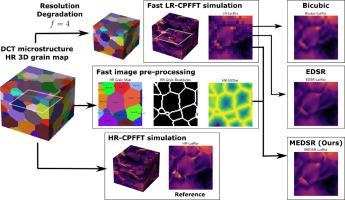Multimodal super-resolution for fast image-based simulation of crystal plasticity
IF 7.3
1区 工程技术
Q1 ENGINEERING, MULTIDISCIPLINARY
Computer Methods in Applied Mechanics and Engineering
Pub Date : 2025-07-11
DOI:10.1016/j.cma.2025.118210
引用次数: 0
Abstract
Crystal Plasticity FFT-based simulations, commonly used to predict crystal lattice rotation fields in polycrystalline materials, are computationally intensive. Reducing the input volume resolution can speed up these simulations, but often at the expense of prediction accuracy. To address this issue, we introduce a Multimodal EDSR (MEDSR) architecture, based on Enhanced Deep Residual Networks for Single Image Super-Resolution (EDSR). MEDSR incorporates multimodal inputs, combining low-resolution lattice rotation fields with high-resolution grain boundary distance fields, a key morphological attribute. The training process includes a gradient-based loss function that emphasizes high-gradient regions, ensuring sharper reconstructions in areas with significant mechanical variation, particularly near grain boundaries. By leveraging morphological data, MEDSR surpasses existing upsampling methods in key quality metrics.

基于图像的晶体塑性快速模拟的多模态超分辨率
基于fft的模拟通常用于预测多晶材料的晶格旋转场,计算量很大。降低输入体积分辨率可以加快这些模拟,但往往以牺牲预测精度为代价。为了解决这个问题,我们引入了一种基于单幅图像超分辨率(EDSR)的增强型深度残差网络的多模态EDSR (MEDSR)架构。MEDSR集成了多模态输入,结合了低分辨率晶格旋转场和高分辨率晶界距离场(一个关键的形态学属性)。训练过程包括一个基于梯度的损失函数,该函数强调高梯度区域,确保在具有显著机械变化的区域(特别是靠近晶界的区域)进行更清晰的重建。通过利用形态学数据,MEDSR在关键质量指标上超越了现有的上采样方法。
本文章由计算机程序翻译,如有差异,请以英文原文为准。
求助全文
约1分钟内获得全文
求助全文
来源期刊
CiteScore
12.70
自引率
15.30%
发文量
719
审稿时长
44 days
期刊介绍:
Computer Methods in Applied Mechanics and Engineering stands as a cornerstone in the realm of computational science and engineering. With a history spanning over five decades, the journal has been a key platform for disseminating papers on advanced mathematical modeling and numerical solutions. Interdisciplinary in nature, these contributions encompass mechanics, mathematics, computer science, and various scientific disciplines. The journal welcomes a broad range of computational methods addressing the simulation, analysis, and design of complex physical problems, making it a vital resource for researchers in the field.

 求助内容:
求助内容: 应助结果提醒方式:
应助结果提醒方式:


